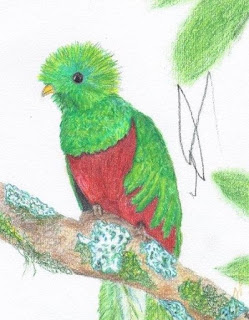 What a busy few months! I have been editing my story, creating character ideas, and editing my friends cookbook Simply Delicious.
What a busy few months! I have been editing my story, creating character ideas, and editing my friends cookbook Simply Delicious.As far as my book is going, the story is pretty much how I like it but even with all my edits the story is about 400 words too long. Usually picture books are under 1,000 words.
Applying the saying "A picture is worth a thousand words" might be my answer. Okay, so I need the pictures to be worth at least 400 words. Once I have rough sketches, and can bring the word count down a little more, I will be ready for a few test readers.
In order to begin planning these "word replacing" illustrations I needed to break the text into pages and spreads. This is the start of a what is considered a picture book dummy. A completed picture book dummy includes the text, a rough idea of where the text will go on the page and rough sketches of the illustrations. This part is going really well. However, it has required a lot more thought and strategic placements than I ever would have imagined. It is an intriguing process.
Things I learned to consider when making a picture book dummy:
- The pace of the story. Making sure there are not too many words on one page with not enough on another.
- Creating suspense with page turns. For example a problem comes up but you don't see any resolution until you turn the page.
- Varying the illustration perspectives to create interest. For instance close up view, far away view, how many pictures per page, birds eye or looking up from below, etc.
- Pictures books have two typical formats. Typically a 32 page or 24 page layout. Research these layouts before trying to create pages and spreads. It can change where page turns are at in the story.
As I tried to visualize how my illustrations might look, I realized that as I had been writing the text the images I had imagined were more like a movie than a picture book. I could see the characters in action. Now I have to pick out the best visual parts of the "movie" in my brain to share with readers. Kind of a funny thing to realize about my story process.
Creating characters and illustration ideas has been a lot of fun for me to work on. As I have read to my children, I am always pouring over the illustrations and picking them apart. This has really given me some good insights into what I like and don't like.
 Some things I like to pay attention to when reading a picture book are:
Some things I like to pay attention to when reading a picture book are:- Colors. Are they realistically or creatively used? What do the colors add to the mood of the story? Are they bright or more earthy tones?
- What mediums are used to create the pictures?
- Are the characters memorable or entertaining?
- What do the illustrations add to the text. Is there a side story that you will only catch by looking at the pictures?
- Are there borders to the pictures? Do the characters or other parts of the illustrations stay in the border or do they pop out on occasion?
Working with my friend Mirlandra on her cookbook Simply Delicious was a treat. Even though our books are different there was still a process I got to watch of creating, organizing, editing and then editing it again when I learned something new. It was really neat to see thing come together for her. I only saw a fraction of the work that went into it, but her work really paid off.
While researching and trying to understand the path to getting published I bought a book. The book is Children's Writers and Illustrators Market 2018. This has been really helpful, especially because you get a year online subscription to Writer's Market with it which has some awesome tools to find agents and lots of resources for learning and connecting you with what you need.
Learning about agents and what they want, and don't want, has been interesting. Each agent is so different in what type of work they want to see. It is soooo important to do your homework before you submit your work to someone. Find a good match and learn how they want to have work submitted to them for consideration. Because I am both author and illustrator of my book, that also adds an extra twist into how it all works. It also changes who would be interested in looking at my submission.
My next goals are to finish my picture book dummy and complete rough developments of all the characters in the story. Creating this book is teaching me so much! See you in January... LOL...this book is taking way longer than I imagined!













